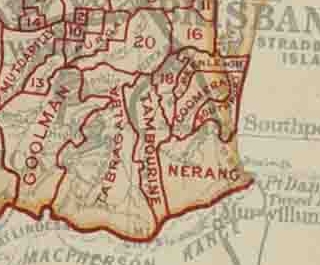1942 to 1947


For this edition, we will concentrate on the construction of Camp Cable which became one of the largest US Training and Transit Camps in Australia, and had a major impact on the local area providing opportunities to local businesses for Tamborine, Logan Village and surrounds.
During World War II in 1942, a tented camp was requested for 20,000 men. Land was selected between Tamborine and Logan Village either side of the Canungra branch railway line (in parts now known as Yarrabilba) to build the training base for the American 32nd “Red Arrow” Infantry Division. (The US Division was sent to Australia in return for the Australian 9th Division remaining in the Middle East at the time.) Camp Tamborine, as initially known, was built using private contractors employed by the Allied Works Council. The estimated cost was to be £380,000 for the construction of mess halls/kitchens with boiler houses, bath houses, latrines, tank stands and hospital wards. Most of the work was divided between five contractors: Stuart Bros, Queensland Building and Engineering (Stronach), PR Ayre, J Hutchinson & Sons, and H Taylor. In preparation for the training camp, the Australian Defence Canteen Service took over Tamborine Memorial Hall for use as a major storage facility in 1942.
The main camp area lay between Waterford-Tamborine Road in the west, Steele Road in the east, with the Divisional Headquarters being south of Camp Cable Road, just west of its intersection with Waterford-Tamborine Road. The most southern section of the camp was the 155th Station Hospital which was just south of the Albert River and east of Waterford-Tamborine Road. A theatre was also located here, from which General MacArthur and Eleanor Roosevelt both addressed the troops in 1943. As well as a well-stocked library for leisure hours, it was noted, by the Courier Mail at the time, that “there were still plenty of routine jobs to be done around the camp, such as peeling potatoes”.
The Americans built Camp Cable Road to link up with Jimboomba as well as sealing the road between Tamborine and Logan Village. Bridges were also strengthened on the Waterford-Tamborine and Beenleigh-Tambourine roads to carry 20 ton loads, and new internal roads were formed and gravelled within the camp. The water supply was pumped from the Albert River and stored in large tanks, able to provide 12,000 gallons (54,600 litres) per hour to the camp. Water mains were later installed to some areas of the camp as well as electricity was also eventually installed to some areas.
The final count for construction included 110 mess huts of several sizes, 99 bath houses, 217 latrines, 3 pump houses, 128 tank stands, 5 hospital wards and 3 nurses quarters. Another 12 mess huts, 27 bath houses and 2 latrines were built by the US Army. In addition to the above work, ten curved truss (igloo) buildings were built at Tamborine, plus four at Logan Village which were serviced by a new railway siding – their footprints can still be seen between the main road and the railway at Logan Village, south of Quinzeh Creek Road.
In 1944, construction stopped and the camp was handed over to the Australian Army, with the hospital handed over in 1945. The Military Post Office at Camp Cable closed 11 January 1946. From 1946, there remained a lot of building debris on private land including concrete slabs, latrine pits, drains, roads, gravelled areas, rifle ranges, trenches, foxholes, pillboxes, dugouts, and a grenade range. There was also the problem of barbed wire entanglements for livestock and unexploded ammunition (UXO). In the late 1940s, local farmers received compensation for damage. In particular, a farmer called Stimpson, wanted his property cleaned up, re-fenced and compensation for the loss of a valuable heifer which accidentally ate scrap metal left behind from tank construction and died.
Three memorials are located east of the intersection of Camp Cable Road and the Waterford-Tamborine Road. One is in honour of Sergeant Gerald O’Cable, (of the Red Arrow Brigade), who was first to die from the Division, killed during transport along the southern Australian coast when torpedoed by a Japanese submarine, and for whom the Camp was later renamed to Camp Cable on 30 August 1942. Another is in honour of ‘Vicksburg’, a small dog who had stowed away on the SS Lurline and not discovered until the US Division was four days out of San Francisco. She became the Division’s mascot but was accidentally killed in Southport in a road accident on 8 October 1942. The other monument is in honour of Sergeant Robert Dannerburg, killed in action on 2 June 1942. He saved a fellow soldier after his platoon walked into a sniper’s nest in New Guinea.
In late 1946, the Camp Cable buildings were saved from bush fires and made ready for Public Auction. Such were the buildings and equipment so sought after by the public, it was common practice to ‘Toss A Coin’ for the right to win a purchase in order to decide ownership after keen bidding (especially by council buyers and farmers). Earlier in 1946, the Canungra Hall burned to the ground and a temporary hall was brought to Canungra from the dispersing Army Camp for the town’s use.
In 1947, Tamborine Shire’s population reached 2596 people, declining somewhat from the 1930s due to the war, and the Australian Blue Book described Tamborine Shire as quite a substantial town.
